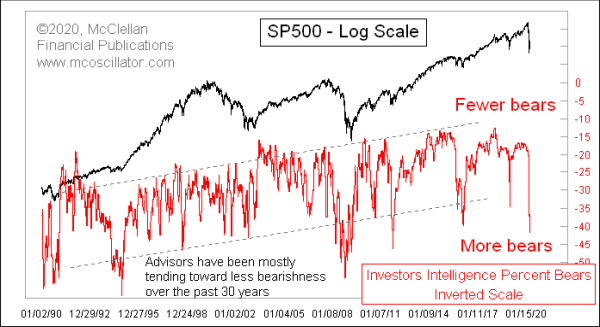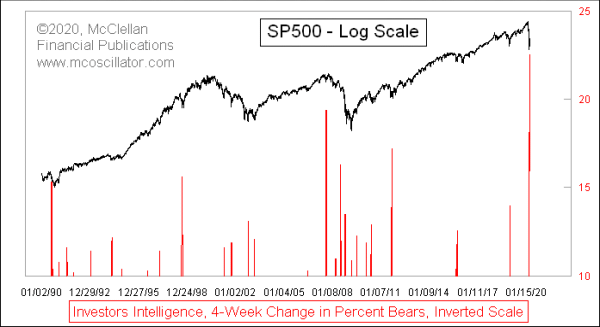
The past 3 weeks have seen a huge surge in the bearish percentage among the investment advisors and newsletter writers in the Investors Intelligence survey. Often these data are shown as the spread between the bulls and the bears, but for this week I thought it would be informative to look at just the bears alone. And to better correlate with price action, I have plotted those data on an inverted scale in the chart above.
One important point to note in this chart is how these data have been trending toward a different range of values over the past 3 decades. From 1990 to 2000, the average weekly value was 35%. But from 2010 to present, the average is 21%. Part of this results from a change in who gets surveyed. Some of the analysts and newsletter writers who were active in the 1990s have retired, and been replaced by others. Styles of analysis have changed as well. And the Fed has helped to keep the market aloft, so staying bearish has not worked very well in the long run and analysts have made what is arguably an appropriate change to less bearishness.
In their March 24 weekly report, Investors Intelligence showed 41.7% bears, which is the highest since 2011. These extreme values for the bearish percentage tend to mark exhaustive bottoms for the stock market. 2008 was different, however, and we saw some protracted big readings for the bearish percentage.
One factor which is different this time is how suddenly this selloff and this rush to bearishness has come about. To help portray that, I created this next chart, which looks at the 4-week change in the bearish percentage:

I have also done a little bit of trickery with the scaling, setting the lower boundary at +10 which cuts off a lot of the data. This is intentional, and it helps us to better see what these extreme 4-week change readings mean for stock prices, without getting distracted by all of the noise in seeing all of the postings.
My data go back to 1990, and this is the largest 4-week change in the bearish percentage in all of that time. The rest of the readings which are at all similar to this new record have tended to appear at moments of at least temporary exhaustion for the stock market.
No sentiment reading by itself is enough to compel the stock market to put in a bottom and start going up. They can hint at it, but the stock market can still do whatever it wants to do. The message to take from seeing this sentiment extreme is that there is a lot of potential energy stored up which can help the market to rebound, as all of the investors and analysts who are on the sidelines or outright bearish can be harnessed and turned into buying pressure as they see the uptrend leaving without them.
Tom McClellan
Editor, The McClellan Market Report